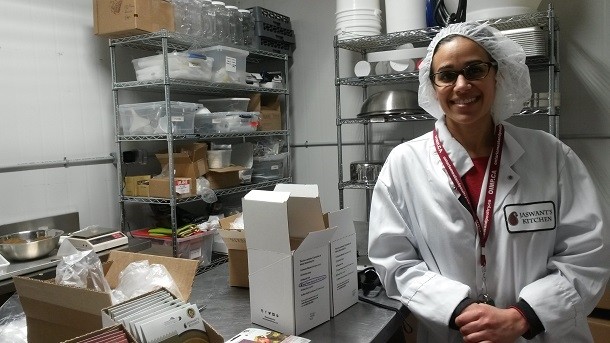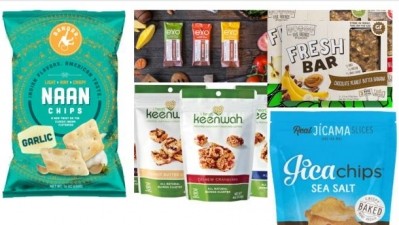Jaswant’s Kitchen makes cooking Indian food from scratch at home ‘easier on the brain’

The young company, which works out of the Toronto-based incubator and accelerator Food Starter, recently began selling its authentic Indian spice blends in small pouches with colorful, lightweight cardboard sleeves in addition to its original jars.
While the pouches are more expensive per gram than the jars, consumers are flocking to the new design because it is so user-friendly, says Simi Kular, who helped co-found the company with her mother and sister.
She explains that the front of the new package showcases a photo of a dish that can be made with the spice blend, and on the back is a recipe that is scaled to the exact amount of spice in the product. But what makes the packaging particularly consumer-friendly is a grocery list alongside the recipe that details how much of each ingredient shoppers need to pick up to make the featured dish.
Before marketing the blends in pouches, they were sold in jars, which are still available online at a higher value price point, Kular said. She explained that the jars sold well when representatives from the company were in the store to explain to consumers how to use them and direct them to the website where the recipes were, but when the jars simply sat on the shelves, people wouldn’t know what to do with them.
“With our spice blends you can do many different things, and that was difficult to convey on a small jar. That is why we went to this more direct approach, which is recipes that people would recognize from an Indian restaurant but don’t know how to recreate them,” Kular said.
She added that many of the recipes also have been simplified, although they still have an authentic flavor, so that anyone can recreate them and have the dish consistently turn out correctly every time.
Building on that idea, Kular explains that the new packaging and focus on recipes is an extension of the company’s overarching mission to make cooking Indian food from scratch at home simple.
“People find it pretty intimidating to get started with Indian cuisine because there are so many spices involved and the recipes can be complicated. So, we have done the hard part of blending all the spices in just the right proportions and we have the recipes to go with everything,” she said.
She also noted that even loyal customers who have bought the blends in the jars and know how to use them prefer the new packaging because they can easily pass it off to the nanny or go on auto-pilot.
“It is just easier on the brain,” Kular said.
Expanding into the US
The new packaging helped the young company catch the eye of a buyer for Whole Foods Market at Summer Fancy Food in 2016, and as a result the spice blends will be available in the mid-Atlantic region of the US starting in May.
“This is our first big chain. We are in about 40 independent retailers here in Toronto and we sell on the website and shopping channel and Amazon,” but securing a 55-store deal with Whole Foods is a game-changer for the company, Kular said.
“The US is so much bigger of a market than Canada – it is crazy,” she said. “It is just a completely different beast and it would be great if we could enter that market. In order to really grow, you have to expand beyond that border.”
Handling growing pains
It also is a bit intimidating, she acknowledged. She explained that the company currently fills many of the spice pouches by hand but if business keeps expanding, the company will need to reconsider its packaging.
“We are at this cusp, where we are going to have to figure out some new things to be able to do the production that we need to do if we started getting into bigger chains,” she said, explaining if “all of a sudden you get an order from 55 stores in one month then you have to ramp up production significantly.”
For example, to meet the Whole Foods order, Kular said the company hired temporary workers to help fill the void, but, she added, “eventually that is not going to be sustainable. The labor costs would end up being so high that it is better to move to a machine.”
Acquiring a new machine, however, comes with its own set of challenges beyond simply needing the volume to justify the purchase, Kular said.
She explained that some of the spice blends come in pouches weighing a gram or less, and “it is hard to find machines that do accurate measuring of one gram of spice in pouches that aren’t $40,000.”
One option might be to combine the two spice blends into one pouch, which would simplify the packaging process dramatically, Kular said. But if the company does that, Kular says she worries about compromising the integrity of the cooking experience and the layering of flavors that comes with a finishing spice.
While grappling with these growing pains, Kular said the company is eager to expand its offerings as well as its reach.
In addition to coming up with new blends and recipes, Kular said the company is exploring how to make a turmeric latte mix that will allow consumers to make and enjoy on-trend golden milk at home.

















